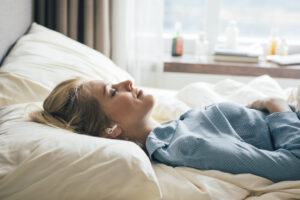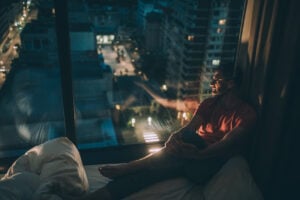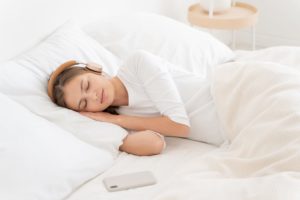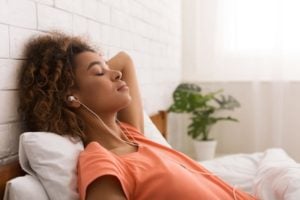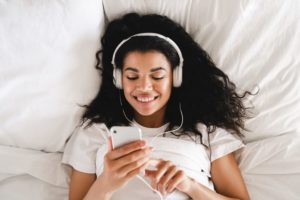Can Pink Noise Help You Sleep?
Many people use sound to block out external noises, in the hopes that it might help them fall asleep faster or improve their sleep quality. Most people are familiar with the concept of white noise, but emerging research indicates a lesser-known type of noise called pink noise may also have benefits for sleep.
What Is Pink Noise?
Pink noise is a sound that contains a random assortment of all the audible frequencies, with more power in the lower frequencies. Specifically, pink noise contains the same overall intensity in each octave , but the volume of individual pitches decreases by 3 decibels with each higher octave. Another name for pink noise is 1/f noise, which describes the way its power is inversely related to its frequency.
Because of the way the human ear works, people perceive pink noise as having a pleasant-sounding, balanced volume across frequencies . Pink noise is often considered more relaxing than white noise, since it does not sound as high-pitched.
Pink noise is prevalent in nature sounds, like wind and rain, and many songs or segments of speech contain elements of pink noise. Researchers have observed patterns similar to pink noise in short segments of birdsong, as well as in some urban soundscapes.
Pink noise is often used as a background or control noise because research has found that it is less distracting than other types of noise. For example, one study found that participants became less stressed after listening to pink noise, compared with the typical sounds of an intensive care unit.
Examples of Pink Noise
Pink noise is often compared to water and nature sounds, such as:
Urban noises such as traffic are also said to be similar to pink noise. Because pink noise resembles many sounds in everyday life, therapists often use pink noise as a tool to treat hearing disorders and tinnitus , or ringing in the ears.
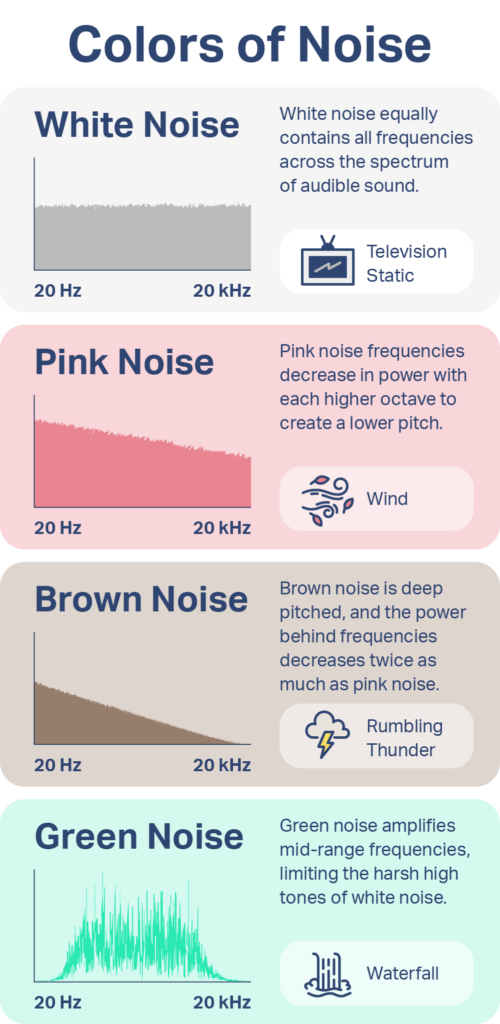
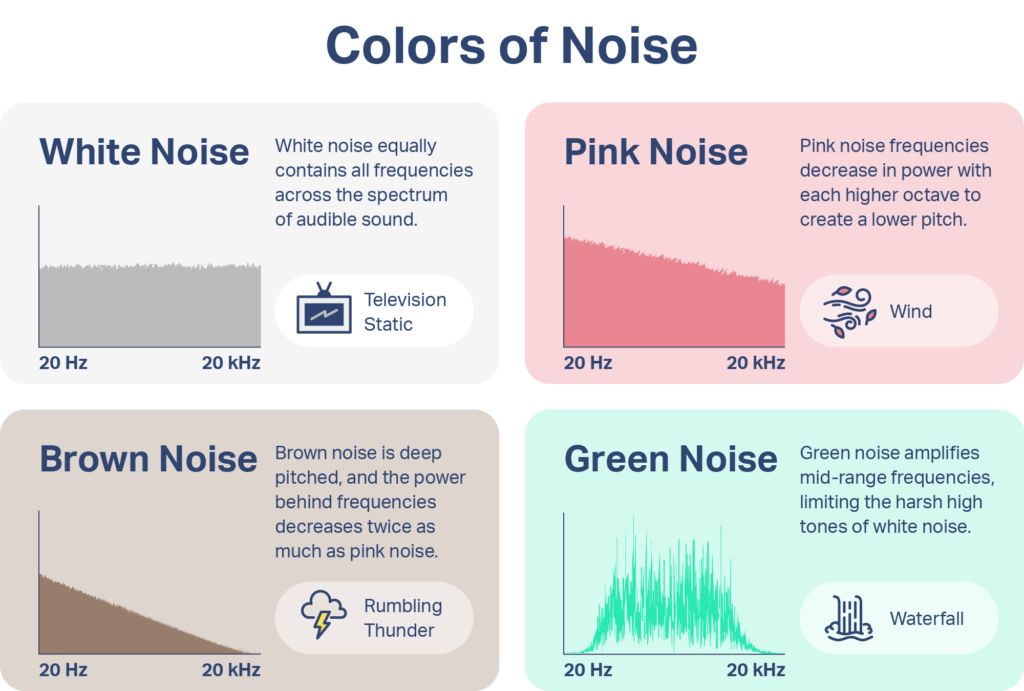
How Pink Noise Impacts Sleep
Initial studies have found pink noise may help people fall asleep faster and obtain better deep sleep. Moreover, pink noise does not appear to cause any strong side effects when played at a reasonable volume.
Decreases Time to Fall Asleep
Steady pink noise may help people relax for sleep by masking bothersome sounds. One early study found that playing steady pink noise at 60 decibels — more or less the volume of a refrigerator — helped participants fall asleep faster .
In a more recent study, researchers programmed a pink noise audio track to decrease in volume as people transitioned into sleep . Not only did this system help participants fall asleep faster, but it also helped them reach deep sleep earlier.
Improves Sleep Quality
Multiple studies have examined how pink noise may be used to enhance sleep quality. One study found that participants’ brain waves gradually slowed in synchrony with a pink noise soundtrack, helping stabilize their sleep .
Researchers have also succeeded at enhancing deep sleep by playing quiet bursts of pink noise at strategic times during the night. Deep sleep is the most restorative sleep stage and it plays a prominent role in immune system functioning . Pink noise enhancement of deep sleep may also have favorable effects for stress hormone levels and cardiovascular health . Playing pink noise in synchrony with specific types of brain waves during sleep may benefit memory .
Pink noise may also help increase sleep spindle density . Sleep spindles are short bursts of activity in the brain that help block out external stimuli while a person sleeps. Promising new research suggests that using pulses of pink noise to increase sleep spindle density may help diminish chronic pain.
In order to obtain the full benefits of pink noise for sleep, it may be necessary for a lab technician to match pink noise timing to a person’s brain waves. However, there is a growing interest in using sounds for sleep, and experts believe devices will soon be available that open up new possibilities for using pink noise at home.

Pink Noise vs. White Noise
Whereas the frequencies of pink noise decrease by 3 decibels per octave, white noise contains all the audible frequencies at equal volumes. As a result, pink noise is perceived as being softer and white noise sounds higher-pitched, like a humming air conditioner.
Like pink noise, white noise includes all the audible frequencies. Because it contains all the sounds at the same volume, white noise has potential benefits for blocking out annoying sounds, treating tinnitus, inducing relaxation, and helping with sleep problems.
White noise has been shown to reduce babies’ crying , help them sleep longer, and reduce pain during infant vaccination .
In one study, pink noise performed better than white noise for improving work performance, although both types of noise imparted benefits.
Additional Colors of Noise
Although pink and white noise are the colors most commonly associated with sleep, there are several other colors of noise. Most of these earned their names because they are distributed similarly to the corresponding color of light. Some of the more commonly used noise colors are:
- Brown/red noise: Red noise, otherwise known as brown noise , decreases by 6 decibels with each higher octave. This gives it a rumbling sound that is even deeper than pink noise, similar to the sound of a steady rainfall or a shower . Some sleep apps offer brown noise for those who prefer a sound that is even deeper than pink noise.
- Blue noise: Blue noise has a power that increases proportionally with each frequency . Because the higher frequencies are comparatively louder, blue noise sounds slightly shriller than pink and white noise.
- Violet noise: Violet noise is the opposite of brown noise, meaning the volume changes at the same rate but becomes louder instead of quieter with each octave. This places it among the higher-pitched noise colors and makes it useful for treating tinnitus.
- Gray noise: Gray noise is distributed with more power at higher and lower frequencies and less in the middle frequencies. The result sounds somewhat like white noise, but more balanced.
Some people also assign colors to other types of noise, like orange, black, and green noise. These definitions are not as strict, and they may be used differently by different people.
Finding a Pink Noise Machine
Although pink noise is not as common as white noise, many sleep apps and sound machines offer the option of pink noise. Pink noise soundtracks are also available on YouTube and other websites. To reduce disruptive changes in sound levels while you fall asleep, look for options that play continuous noise, or looped soundtracks that disguise the end of the track.
Be sure to keep the volume at a safe level, bearing in mind you may be listening to it for upward of an hour. Studies have found that 60 decibels is a suitable level for listening to pink noise during sleep, although this depends on your personal preference, your sensitivity to sound, the ambient noise levels in your house, and whether you are listening to a sound machine or using headphones.
Most apps and sound machines offer the option to set the noise to a timer if you prefer not to let it play all night. For those who play pink noise through a smartphone app, a timer also eliminates the need to look at your screen again before falling asleep.
Aside from pink and white noise, many people find it helpful to listen to other sounds when falling asleep, such as light music, nature sounds, or guided meditation tracks. A variety of sleep sounds can be found on our YouTube channel.

Still have questions? Ask our community!
Join our Sleep Care Community — a trusted hub of sleep health professionals, product specialists, and people just like you. Whether you need expert sleep advice for your insomnia or you’re searching for the perfect mattress, we’ve got you covered. Get personalized guidance from the experts who know sleep best.
References
23 Sources
-
Overath, T., Zhang, Y., Sanes, D. H., & Poeppel, D. (2012). Sensitivity to temporal modulation rate and spectral bandwidth in the human auditory system: fMRI evidence. Journal of Neurophysiology, 107(8), 2042–2056.
https://pubmed.ncbi.nlm.nih.gov/22298830/ -
Naal-Ruiz, N. E., Alonso-Valerdi, L. M., & Ibarra-Zarate, D. I. (2021). Data on electroencephalographic activity while exposed to pink noise modified by the frequency responses of three headphone models. Data in Brief, 39, Article 107528.
https://pubmed.ncbi.nlm.nih.gov/34786442/ -
Grabarczyk, E. E., & Gill, S. A. (2019). Anthropogenic noise affects male house wren response to but not detection of territorial intruders. PloS One, 14(7), Article e0220576.
https://pubmed.ncbi.nlm.nih.gov/31365593/ -
Oh, Y., & Lee, S. N. (2021). Low-intensity steady background noise enhances pitch fusion across the ears in normal-hearing listeners. Frontiers in Psychology, 12, Article 626762.
https://pubmed.ncbi.nlm.nih.gov/33597910/ -
Capezuti, E., Pain, K., Alamag, E., Chen, X., Philibert, V., & Krieger, A. C. (2021). Systematic review: Auditory stimulation and sleep. Journal of Clinical Sleep Medicine: JCSM: Official Publication of the American Academy of Sleep Medicine, 10.5664/jcsm.9860. Advance online publication.
https://pubmed.ncbi.nlm.nih.gov/34964434/ -
Kawada, T., & Suzuki, S. (1993). Sleep induction effects of steady 60 dB (A) pink noise. Industrial Health, 31(1), 35–38.
https://pubmed.ncbi.nlm.nih.gov/8340228/ -
Garcia-Molina, G., Kalyan, B., & Aquino, A. (2020). Closed-loop electroencephalogram-based modulated audio to fall and deepen sleep faster. Annual International Conference of the IEEE Engineering in Medicine and Biology Society. IEEE Engineering in Medicine and Biology Society. Annual International Conference, 2020, 565–568.
https://pubmed.ncbi.nlm.nih.gov/33018052/ -
Zhou, J., Liu, D., Li, X., Ma, J., Zhang, J., & Fang, J. (2012). Pink noise: Effect on complexity synchronization of brain activity and sleep consolidation. Journal of Theoretical Biology, 306, 68–72.
https://pubmed.ncbi.nlm.nih.gov/22726808/ -
Schade, M. M., Mathew, G. M., Roberts, D. M., Gartenberg, D., & Buxton, O. M. (2020). Enhancing slow oscillations and increasing N3 sleep proportion with supervised, non-phase-locked pink noise and other non-standard auditory stimulation during NREM sleep. Nature and Science of Sleep, 12, 411–429.
https://pubmed.ncbi.nlm.nih.gov/32765139/ -
Danilenko, K. V., Kobelev, E., Yarosh, S. V., Khazankin, G. R., Brack, I. V., Miroshnikova, P. V., & Aftanas, L. I. (2020). Effectiveness of visual vs. acoustic closed-loop stimulation on EEG power density during NREM sleep in humans. Clocks & Sleep, 2(2), 172–181.
https://pubmed.ncbi.nlm.nih.gov/33089198/ -
Besedovsky, L., Ngo, H. V., Dimitrov, S., Gassenmaier, C., Lehmann, R., & Born, J. (2017). Auditory closed-loop stimulation of EEG slow oscillations strengthens sleep and signs of its immune-supportive function. Nature Communications, 8(1), 1984.
https://pubmed.ncbi.nlm.nih.gov/29215045/ -
Grimaldi, D., Papalambros, N. A., Reid, K. J., Abbott, S. M., Malkani, R. G., Gendy, M., Iwanaszko, M., Braun, R. I., Sanchez, D. J., Paller, K. A., & Zee, P. C. (2019). Strengthening sleep-autonomic interaction via acoustic enhancement of slow oscillations. Sleep, 42(5), zsz036.
https://pubmed.ncbi.nlm.nih.gov/30753650/ -
Papalambros, N. A., Santostasi, G., Malkani, R. G., Braun, R., Weintraub, S., Paller, K. A., & Zee, P. C. (2017). Acoustic enhancement of sleep slow oscillations and concomitant memory improvement in older adults. Frontiers in Human Neuroscience, 11, 109.
https://pubmed.ncbi.nlm.nih.gov/28337134/ -
Caravan, B., Hu, L., Veyg, D., Kulkarni, P., Zhang, Q., Chen, Z. S., & Wang, J. (2020). Sleep spindles as a diagnostic and therapeutic target for chronic pain. Molecular Pain, 16, 1744806920902350.
https://pubmed.ncbi.nlm.nih.gov/31912761/ -
Schönauer, M., & Pöhlchen, D. (2018). Sleep spindles. Current Biology: CB, 28(19), R1129–R1130.
https://pubmed.ncbi.nlm.nih.gov/30300592/ -
Ngo, H. V., Claussen, J. C., Born, J., & Mölle, M. (2013). Induction of slow oscillations by rhythmic acoustic stimulation. Journal of Sleep Research, 22(1), 22–31.
https://pubmed.ncbi.nlm.nih.gov/22913273/ -
Yoon, H., & Baek, H. J. (2022). External auditory stimulation as a non-pharmacological sleep aid. Sensors (Basel, Switzerland), 22(3), 1264.
https://pubmed.ncbi.nlm.nih.gov/35162009/ -
Lu, S. Y., Huang, Y. H., & Lin, K. Y. (2020). Spectral content (color) of noise exposure affects work efficiency. Noise Health, 22(104), 19–27.
https://pubmed.ncbi.nlm.nih.gov/33243964/ -
Sezici, E., & Yigit, D. (2018). Comparison between swinging and playing of white noise among colicky babies: A paired randomised controlled trial. Journal of Clinical Nursing, 27(3-4), 593–600.
https://pubmed.ncbi.nlm.nih.gov/28618052/ -
Kucukoglu, S., Aytekin, A., Celebioglu, A., Celebi, A., Caner, I., & Maden, R. (2016). Effect of white noise in relieving vaccination pain in premature infants. Pain Management Nursing: Official Journal of the American Society of Pain Management Nurses, 17(6), 392–400.
https://pubmed.ncbi.nlm.nih.gov/27751753/ -
Kübel, S. L., Fiedler, H., & Wittmann, M. (2021). Red visual stimulation in the Ganzfeld leads to a relative overestimation of duration compared to green. PsyCh Journal, 10(1), 5–19.
https://pubmed.ncbi.nlm.nih.gov/33021086/ -
Barozzi, S., Ambrosetti, U., Callaway, S. L., Behrens, T., Passoni, S., & Del Bo, L. (2017). Effects of tinnitus retraining therapy with different colors of sound. The International Tinnitus Journal, 21(2), 139–143.
https://pubmed.ncbi.nlm.nih.gov/29336133/ -
Geere, D. (2011, April 7). White, pink, blue and violet: The colours of noise. WIRED UK., Retrieved February 18, 2022, from
https://www.wired.co.uk/article/colours-of-noise


